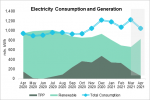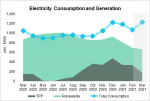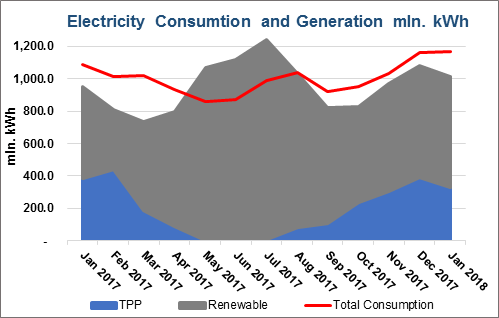In January 2018, Georgian power plants generated 1,014 mln. KWh of electricity. This corresponds to a 6% increase in total generation, compared to the previous year (in 2017, total generation in January was 955.5 mln. kWh). The increase in generation on a yearly basis comes from increase in wind and hydro power generation (more details below).
On a monthly basis, generation decreased by 6% in December 2017 (total generation was 1,080 mln. kWh).
The share of electricity produced by renewable sources increased marginally to 68% of total generation (683 mln kWh), while that of thermal power generation decreased in comparison to December 2017, accounting for 32% of total generation (331 mln. kWh).
Consumption of electricity on the local market was 1,170 mln. kWh (+8% compared to January 2017, and +1% with respect to December 2017). The gap between consumption and generation increased to 156 mln. kWh - 15% of the amount generated in January 2018 (compared to 84 mln kWh and 8% of total generation in December).
Among different sources of electricity, hydropower remained dominant. Specifically, in January 2018, hydropower (HPP) generation amounted to 676 mln. kWh (67% of total), wind power (WPP) was 7 mln. kWh (1% of total), and thermal power (TPP) was 331 mln. kWh (32% of total) (Figure 2). Among hydropower generators, large (regulatory) HPPs produced 51% (342 mln. kWh) of electricity, while seasonal and small HPPs produced 43% (289 mln. kWh) and 7% (45 mln. kWh), respectively (Figure 3).
More Electricity Market Review Articles
-
July 2021 | Electricity Market Review
 In July 2021, Georgian power plants generated 1240 mln. kWh of electricity. This represents a 23% increase in total generation, compared to the previous year (in July 2020, the total generation was 1010 mln. kWh). The increase in generation on a yearly basis comes from the increase of 29% in hydropower generation, while there was a decrease of 91% and 11% in thermal power and wind power generation, respectively. On a monthly basis, generation decreased… Read More
In July 2021, Georgian power plants generated 1240 mln. kWh of electricity. This represents a 23% increase in total generation, compared to the previous year (in July 2020, the total generation was 1010 mln. kWh). The increase in generation on a yearly basis comes from the increase of 29% in hydropower generation, while there was a decrease of 91% and 11% in thermal power and wind power generation, respectively. On a monthly basis, generation decreased… Read More
-
June 2021 | Electricity Market Review
 In June 2021, Georgian power plants generated 1323 mln. kWh of electricity. This represents a 32% increase in total generation, compared to the previous year (in June 2020, the total generation was 999 mln. kWh). The increase in generation on a yearly basis comes from the increase of 32% in hydropower generation, as well as, from an increase in the generation of wind power by 15%. On a monthly basis, generation increased by approximately 8%… Read More
In June 2021, Georgian power plants generated 1323 mln. kWh of electricity. This represents a 32% increase in total generation, compared to the previous year (in June 2020, the total generation was 999 mln. kWh). The increase in generation on a yearly basis comes from the increase of 32% in hydropower generation, as well as, from an increase in the generation of wind power by 15%. On a monthly basis, generation increased by approximately 8%… Read More
-
May 2021 | Electricity Market Review
 In May 2021, Georgian power plants generated 1221 mln. kWh of electricity. This represents a 24% increase in total generation, compared to the previous year (in May 2020, the total generation was 986 mln. kWh). The increase in generation on a yearly basis comes from the increase of 26% in hydropower generation, as well as, from increase in the generation of wind power by 10%. On a monthly basis, generation increased by approximately 48% (in… Read More
In May 2021, Georgian power plants generated 1221 mln. kWh of electricity. This represents a 24% increase in total generation, compared to the previous year (in May 2020, the total generation was 986 mln. kWh). The increase in generation on a yearly basis comes from the increase of 26% in hydropower generation, as well as, from increase in the generation of wind power by 10%. On a monthly basis, generation increased by approximately 48% (in… Read More
-
April 2021 | Electricity Market Review
 In April 2021, Georgian power plants generated 825 mln. kWh of electricity. This represents a 13% decrease in total generation, compared to the previous year (April 2020, the total generation was 944 mln. kWh). The decrease in generation on a yearly basis comes from the decrease of 4% in hydro power generation, as well as, from decrease in the generation of thermal and wind power by 56% and 18%, respectively. On a monthly basis, generation… Read More
In April 2021, Georgian power plants generated 825 mln. kWh of electricity. This represents a 13% decrease in total generation, compared to the previous year (April 2020, the total generation was 944 mln. kWh). The decrease in generation on a yearly basis comes from the decrease of 4% in hydro power generation, as well as, from decrease in the generation of thermal and wind power by 56% and 18%, respectively. On a monthly basis, generation… Read More
-
March 2021 | Electricity Market Review
 In March 2021, Georgian power plants generated 661 mln. kWh of electricity. This represents a 24% decrease in total generation, compared to the previous year (March 2020, the total generation was 867 mln. kWh). The decrease in generation on a yearly basis comes from the decrease of 33% in hydropower generation, however, the generation of thermal and wind power have increased by 16% and 0.9%, respectively. On a monthly basis, generation decreased by approximately 4%… Read More
In March 2021, Georgian power plants generated 661 mln. kWh of electricity. This represents a 24% decrease in total generation, compared to the previous year (March 2020, the total generation was 867 mln. kWh). The decrease in generation on a yearly basis comes from the decrease of 33% in hydropower generation, however, the generation of thermal and wind power have increased by 16% and 0.9%, respectively. On a monthly basis, generation decreased by approximately 4%… Read More
- 1
- 2











